Home Decor
How To Clean Rattan Furniture just in few Steps
Cleaning rattan furniture is an important part of its maintenance to keep it looking great and in good condition for years to come. Rattan furniture is a popular choice for many homeowners due to its natural beauty and durability. However, it’s important to use the right techniques to clean rattan furniture without damaging it. In this article, we’ll show you all about rattan furniture and how to clean rattan furniture in a few easy steps.
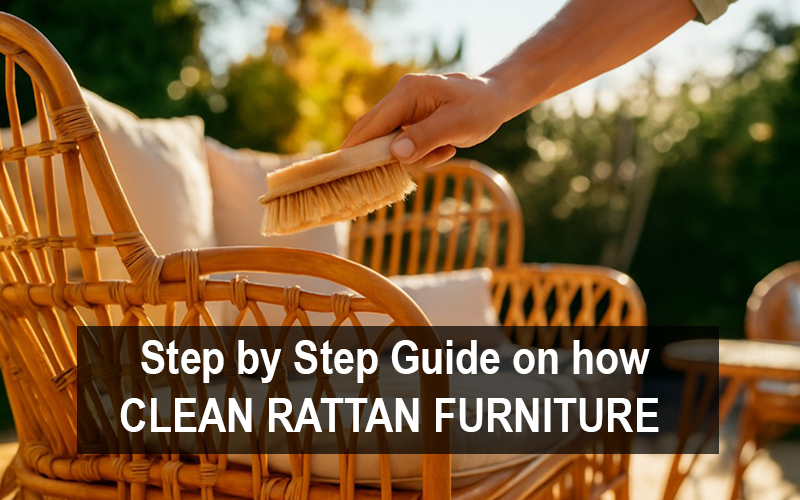
What is rattan furniture?
Rattan furniture refers to pieces made using rattan – a vine-like plant that grows abundantly in tropical regions. Traditionally, natural rattan is prized for its strength, flexibility, and lightweight nature, making it perfect for crafting furniture and woven light fixtures. In addition to natural rattan, modern designs also utilize synthetic rattan, which is made from materials like polyethylene or resin. Synthetic rattan offers greater resistance to moisture, UV rays, and wear, making it ideal for outdoor use. Both types bring a warm, textured look to living spaces, but they differ in characteristics and usage.
Natural Rattan vs Synthetic Rattan
Here’s a comparison between natural and synthetic rattan:
| Feature | Natural Rattan | Synthetic Rattan |
|---|---|---|
| Material Source | Harvested from real rattan vines | Made from synthetic resin or plastic |
| Appearance | Organic, rustic, earthy look | Can mimic natural look; often more uniform |
| Durability | Strong but sensitive to moisture & sun | Highly resistant to weather & UV rays |
| Ideal Use | Indoor or covered outdoor spaces | Outdoor and all-weather environments |
| Eco-Friendliness | Biodegradable and natural | Non-biodegradable, but long-lasting |
| Maintenance | Requires gentle care and dry storage | Easy to clean and low maintenance |
Both natural and synthetic rattan offer unique benefits depending on the intended use and desired style.
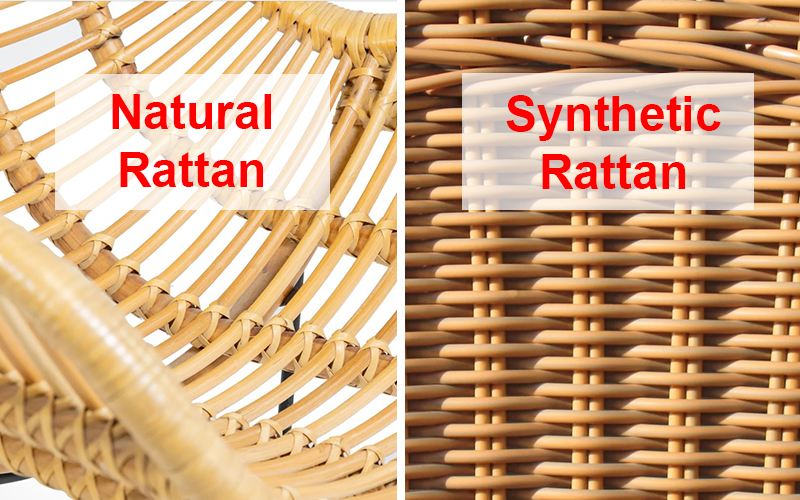
What does Rattan Furniture include?
Rattan furniture can be made in a variety of styles, from traditional to modern, and can be used both indoors and outdoors. It is often woven by hand and can be left natural or stained to a variety of colors. Natural rattan furniture is a popular choice for many homeowners due to its natural beauty, durability, and eco-friendliness.
Some of the most common rattan furniture pieces include:
- Chairs: Rattan chairs are available in many different styles, from traditional to modern, and can be used as dining chairs, accent chairs, or outdoor patio chairs.
- Sofas and loveseats: Rattan sofas and loveseats are comfortable and stylish seating options that can be used in a variety of indoor and outdoor spaces.
- Tables: Rattan tables are available in many different shapes and sizes, including coffee tables, side tables, and dining tables.
- Ottomans and footstools: Rattan ottomans and footstools are versatile pieces of furniture that can be used as a seating option or as a place to rest your feet.
- Storage furniture: Rattan storage furniture includes cabinets, shelves, and baskets that are ideal for organizing and storing items in a stylish and functional way.
- Outdoor furniture: Rattan outdoor furniture is designed to withstand the elements and can include chairs, tables, sofas, and loungers.
Rattan furniture is available in a range of styles and designs, from classic to modern, and can be used in many different rooms and outdoor spaces to create a unique and stylish look.
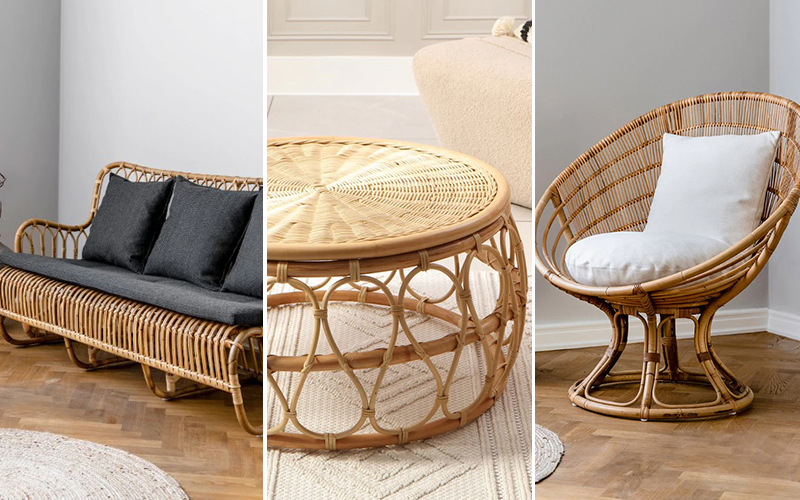
Tools & Supplies for Cleaning Rattan Furniture
Having the right cleaning tools and supplies on hand makes rattan furniture care easier and more effective. Because rattan has a textured surface and tight weaves, special care must be taken to clean both visible and hidden dirt without damaging the fibers.
4.1 Essential Cleaning Tools
- Soft-bristled brush: Ideal for cleaning in between weaves and textured areas. A toothbrush or small detailing brush can help reach difficult spots.
- Feather duster or microfiber cloth: Perfect for weekly dusting without scratching or snagging the fibers.
- Vacuum with brush attachment: Great for removing loose dirt and debris from corners and under cushions. Choose a low-suction setting.
- Spray bottle: Useful for evenly misting cleaning solution on surfaces without over-wetting.
- Bucket or basin: For mixing mild soap solutions.
4.2 Safe Cleaning Solutions
- Mild dish soap and warm water: A universal and gentle solution for both natural and synthetic rattan. Always use in moderation.
- White vinegar and water (1:1 ratio): Excellent for disinfecting and treating light mildew on natural rattan.
- Baking soda paste: Useful for spot-cleaning stains or absorbing odors.
- Wood polish or boiled linseed oil: Helps preserve and moisturize natural rattan, preventing brittleness and cracking.
Avoid using:
- Bleach or ammonia-based products: These can damage natural rattan and discolor finishes.
- Harsh scrubbing pads: They may fray or break delicate rattan fibers.
- Excessive water: Rattan should never be soaked, especially natural types.
4.3 Optional Maintenance Items
- Furniture wax or clear varnish: Adds a protective finish to natural rattan.
- UV protectant spray (for synthetic rattan): Helps reduce fading from sunlight exposure.
- Cotton swabs: Great for cleaning tight curves or inner joints.
Having a dedicated cleaning kit for your rattan furniture can streamline your maintenance routine and ensure each cleaning task is done safely and effectively. Choosing the right tools not only protects your investment but also keeps your furniture looking pristine and well-loved.

How Often Should You Clean Rattan Furniture?
Proper maintenance of rattan furniture is essential to preserve its beauty and structural integrity. Because rattan is a natural, porous material, it can accumulate dust, absorb moisture, and become a breeding ground for mold or mildew if not cleaned regularly. But how often should you actually clean your rattan furniture?
3.1 Weekly Light Cleaning Rattan Furniture
For indoor rattan furniture, a weekly light dusting is recommended. Use a feather duster, soft cloth, or a handheld vacuum with a brush attachment to gently remove loose dust and dirt. This helps prevent buildup in the weaves and joints, especially in intricately woven pieces. Even for synthetic rattan used outdoors, a quick wipe-down every week with a dry or slightly damp cloth helps maintain its appearance and prevents airborne debris from settling in the crevices.
3.2 Monthly Deep Cleaning Rattan Furniture
Once a month, it’s wise to give your rattan furniture a more thorough cleaning. This includes wiping all surfaces with a damp cloth and mild soap solution. For natural rattan, use minimal water to avoid weakening the fibers. Synthetic rattan can tolerate more moisture, making it easier to clean.
During this deep cleaning, use a soft brush (like a toothbrush or small paintbrush) to reach into tight corners and remove accumulated dirt. Ensure the furniture is dried thoroughly afterward to avoid mildew growth.
3.3 Seasonal Maintenance Rattan Furniture
Every 4 to 6 months, conduct a full maintenance routine:
- Inspect for wear, cracks, or splitting in the rattan fibers
- Tighten loose joints or screws
- Apply a natural oil (like boiled linseed oil) to nourish and protect natural rattan
- Reapply protective coating (like clear varnish or sealant) if the piece is exposed to humidity or used outdoors
This seasonal care is especially important if the furniture is in a high-humidity environment or near windows with direct sunlight, which can cause drying and fading.
3.4 Clean Outdoor Rattan Furniture
Synthetic rattan furniture placed outside may require more frequent cleaning depending on weather exposure. In pollen-heavy seasons or after storms, rinse with a hose and wipe down surfaces. Covering or storing your furniture when not in use can significantly reduce how often deep cleaning is necessary.
In short:
- Light clean: Weekly
- Deep clean: Monthly
- Full maintenance: Every 4–6 months
- Outdoor rattan: As needed (bi-weekly to monthly depending on environment)
Following this schedule not only keeps your rattan furniture looking beautiful but also extends its lifespan by preventing structural and surface damage.
| Type of Cleaning | Frequency | Purpose / Notes |
|---|---|---|
| Light Cleaning | Weekly | Remove surface dust with duster, vacuum, or dry cloth. |
| Deep Cleaning | Monthly | Clean with damp cloth and mild soap; use brush for crevices. |
| Full Maintenance | Every 4–6 months | Inspect, tighten joints, apply oil or protective finish. |
| Outdoor Rattan Care | Bi-weekly to Monthly | Rinse off dirt, especially after storms or during pollen-heavy seasons. |
How To Clean Rattan Furnitures Step-by-Step
Cleaning natural rattan furniture requires a gentle and methodical approach to avoid damaging the fibers. Here’s a step-by-step guide to ensure thorough and safe cleaning:
Step 1: Dust the Surface
Start by removing dust and loose debris using a feather duster, soft microfiber cloth, or a vacuum cleaner with a brush attachment. Focus on corners, crevices, and joints where dust tends to accumulate.
Step 2: Prepare a Mild Cleaning Solution
Mix a small amount of mild dish soap with warm water in a bucket. Dip a soft cloth into the solution, then wring it out thoroughly to avoid soaking the rattan.
Step 3: Wipe Down the Furniture
Gently wipe the rattan surfaces with the damp cloth. For tightly woven areas or stubborn dirt, use a soft-bristled brush or an old toothbrush to reach into crevices.
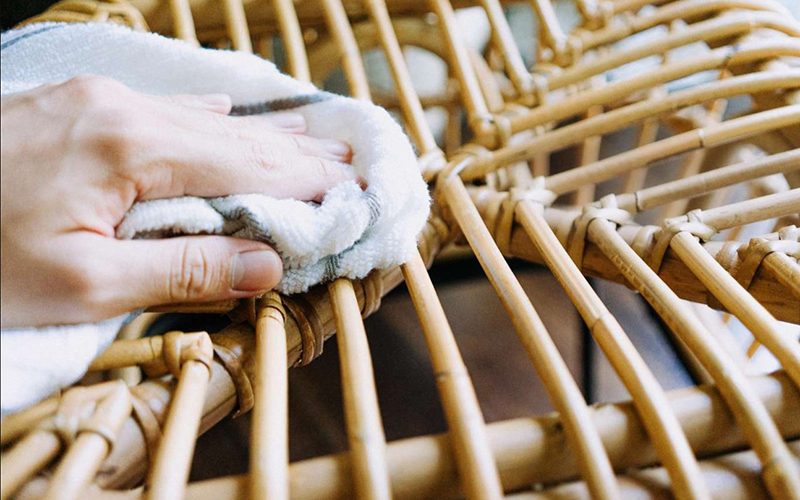
Step 4: Spot Treat Mold or Stains
For any signs of mold, mildew, or stains, use a 1:1 mixture of white vinegar and water. Apply the solution to the affected area with a cloth or spray bottle, then scrub gently with a soft brush. Rinse the area with a clean damp cloth afterward.
Step 5: Dry Thoroughly
Use a clean, dry towel to blot away excess moisture. Then, allow the furniture to air dry completely in a shaded, well-ventilated area. Never leave natural rattan furniture under direct sunlight while wet, as this can cause warping or fading.
Step 6: Condition the Rattan (Optional)
Once dry, you can apply boiled linseed oil or a light wood polish to nourish the rattan and restore its natural sheen. Use a clean cloth to apply the oil, let it absorb, then buff gently.
Following this process every month will help your natural rattan furniture stay clean, supple, and long-lasting
How to Clean Outdoor Synthetic Rattan Furniture
Synthetic rattan, often made from resin or polyethylene, is commonly used for outdoor furniture due to its durability and weather resistance. While it’s easier to maintain than natural rattan, regular cleaning is still important to prevent buildup of grime, mold, or mildew.
Step 1: Rinse Off Dirt
Start by using a garden hose to rinse off dust, pollen, and debris. Avoid using high-pressure settings, as they may damage the weave or cause moisture to penetrate areas that are hard to dry.
Step 2: Clean with Soapy Water
In a bucket, mix mild dish soap with warm water. Dip a soft-bristled brush into the solution and scrub the surface in circular motions. Focus on armrests, seat areas, and any crevices where dirt can accumulate.
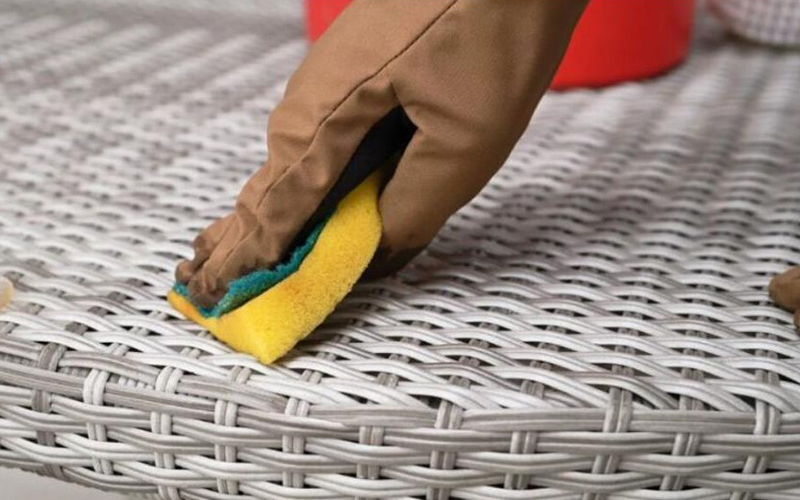
Step 3: Address Mildew or Stains
For mildew-prone areas or visible stains, spray a mixture of vinegar and water directly onto the affected surface. Let it sit for 5–10 minutes, then scrub with a soft brush. Rinse thoroughly with clean water afterward.
Step 4: Dry Completely
Use a dry cloth to remove excess moisture and let the furniture air dry in the sun or a breezy area. Although synthetic rattan is UV-resistant, long-term exposure to harsh sunlight may still cause fading. Consider applying a UV protectant spray to extend its life.
Step 5: Cover or Store
When not in use, cover the furniture with waterproof covers or store it in a shed or garage. This prevents unnecessary exposure to rain, sun, and dirt, minimizing cleaning needs and extending the furniture’s lifespan.
By following this routine, you can keep your outdoor rattan furniture looking fresh, clean, and inviting throughout the seasons.
How to Remove Mold Rattan Furniture
Mold and mildew are common issues with rattan furniture, especially in humid climates or if the furniture has been exposed to moisture. Left untreated, they can not only stain the surface but also weaken the natural fibers. Here’s how to safely remove mold or mildew from rattan:
Step 1: Work in a Well-Ventilated Area
Take the furniture outdoors if possible, or ensure the room is well-ventilated. This helps disperse mold spores and speeds up the drying process.
Step 2: Dry Brush the Affected Area
Use a dry, stiff brush to gently scrub off visible mold or mildew. Do this carefully to avoid spreading spores or damaging the weave.
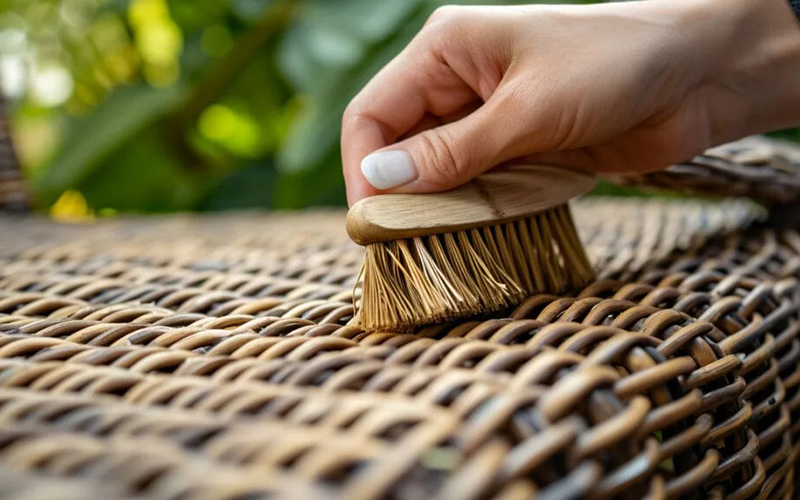
Step 3: Apply a Cleaning Solution
Mix a 1:1 solution of white vinegar and water in a spray bottle. Spray it onto the affected areas and let it sit for 5–10 minutes. Vinegar is a natural antifungal and helps kill mold spores.
For stubborn stains, sprinkle a bit of baking soda on a damp cloth and scrub gently. Do not over-saturate the rattan.
Step 4: Wipe and Rinse
Use a clean, damp cloth to wipe away the vinegar and mold residue. Follow with a dry cloth to remove excess moisture.
Step 5: Allow to Dry Thoroughly
Let the furniture dry completely in a shaded, airy location. Avoid direct sunlight as it may cause the fibers to become brittle.
Repeat this process if necessary, and consider applying a protective oil or sealant once the furniture is fully dry.
How Maintaining Rattan Furniture – Best Tips
Regular maintenance not only keeps your rattan furniture clean but also helps preserve its aesthetic and structural quality for years. Here are some expert tips to get the most out of your rattan pieces:
Keep It Dry
Avoid placing natural rattan furniture in overly humid or wet environments. Use dehumidifiers indoors if necessary, and store outdoor furniture during rainy seasons.
Avoid Direct Sunlight
Prolonged exposure to direct sunlight can cause rattan to fade and become brittle. Position indoor furniture away from windows or use sheer curtains to filter sunlight. For outdoor furniture, consider shaded areas or protective covers.
Use Cushions and Pads
Seat cushions not only add comfort but also help distribute weight evenly, reducing stress on the rattan structure. Use pads or rubber stoppers under furniture legs to prevent damage to both the furniture and floors.
Rotate Items
If you use your furniture regularly, rotate it occasionally to ensure even wear and prevent one side from aging faster than the other.
Store Properly During Off-Seasons
When not in use, especially for outdoor pieces, store rattan furniture in a dry, sheltered area. Cover it with a breathable fabric cover to prevent dust accumulation and mildew.
Reapply Oil or Varnish
Apply boiled linseed oil, furniture wax, or a clear varnish every 6–12 months to help maintain the rattan’s sheen and flexibility. This step is crucial for natural rattan.
Avoid Common Mistakes When Clean Rattan Furniture
Rattan may look tough, but it requires gentle care. Avoid these common cleaning and maintenance mistakes to preserve its beauty and lifespan:
Using Excessive Water
Saturating rattan with water can cause the fibers to swell, warp, or rot. Always use a damp—not soaking—cloth, and dry thoroughly.
Using Harsh Chemicals
Bleach, ammonia, and other abrasive cleaners can discolor or damage the surface of natural rattan. Stick to mild, natural solutions like diluted vinegar or dish soap.
Scrubbing Too Hard
While it’s important to remove grime, scrubbing too aggressively with stiff brushes can fray the fibers or cause breakage, especially on older or dry furniture.
Leaving Rattan Furniture Wet
After cleaning or rain exposure, never leave rattan furniture wet. Always wipe dry and allow it to air out to avoid mold and mildew growth.
Ignoring Small Repairs
Loose weaves or broken strands should be fixed promptly. Delaying minor repairs can lead to bigger issues and even irreversible damage.
By avoiding these pitfalls, you’ll ensure that your rattan furniture stays in excellent condition and continues to add natural beauty to your space for many years.
FAQs: Common Questions About Rattan Furniture
Q1: Can I use water to clean rattan furniture?
Yes, but only in moderation. Use a damp (not soaking) cloth with mild soap. Avoid over-saturating the material, especially natural rattan, as excess moisture can cause swelling, warping, or mold.
Q2: What’s the difference between natural and synthetic rattan?
Natural rattan is made from the rattan palm and is best suited for indoor use. It’s more sensitive to moisture and sunlight. Synthetic rattan, often made from resin, is designed for outdoor use and is more durable and weather-resistant.
Q3: How do I keep rattan furniture from drying out or cracking?
Apply boiled linseed oil or a natural wood conditioner every 6 –12 months to maintain flexibility and prevent brittleness. Avoid placing the furniture in direct sunlight for extended periods.
Q4: Can I pressure wash outdoor synthetic rattan?
It’s not recommended. The high pressure can damage the weave or force water into places where it can’t dry easily, leading to mold or structural damage. Use a garden hose with moderate pressure instead.
Q5: What should I do if my rattan furniture starts to squeak or creak?
Squeaking is usually a sign of loose joints or dry fibers. Tighten any screws or fasteners, and consider applying a small amount of oil to nourish the material and reduce friction.
Q6: How do I remove bad odors from rattan furniture?
Sprinkle baking soda on the affected area and let it sit for a few hours before vacuuming it off. You can also wipe the surface with a vinegar-water solution to neutralize odors.
Keywords: how to clean rattan furniture, cleaning rattan furniture, clean rattan furniture, rattan furniture maintenance, cleaning tips for rattan furniture.
Conclusion
Properly cleaning and maintaining your rattan furniture ensures that it remains beautiful, functional, and long-lasting. Whether you’re caring for natural indoor pieces or synthetic outdoor sets, a consistent cleaning routine and a few mindful practices can go a long way in preserving their integrity and charm.
At VietshopDesign, we are passionate about handcrafted beauty and sustainable living. Our collection of handcrafted rattan and bamboo pendant lights is thoughtfully made to complement both traditional and modern interiors. If you appreciate the natural elegance of rattan furniture, you’ll love the warmth and texture our lighting brings to any space.
We invite you to explore our curated selection at vietshopdesign.com and discover how our artisanal lighting pieces can elevate your home. Whether you’re refreshing your living room, bedroom, or patio—let nature and craftsmanship light your way.
Visit us today and bring home a touch of timeless design.





















Id like to thank you for the efforts you have put in penning this site. Im hoping to see the same high-grade blog posts by you in the future as well. In fact, your creative writing abilities has inspired me to get my own site now 😉
Good post. I learn something new and challenging on blogs I stumbleupon on a daily basis. Its always exciting to read content from other authors and use a little something from other web sites.
Thank you for your guide!